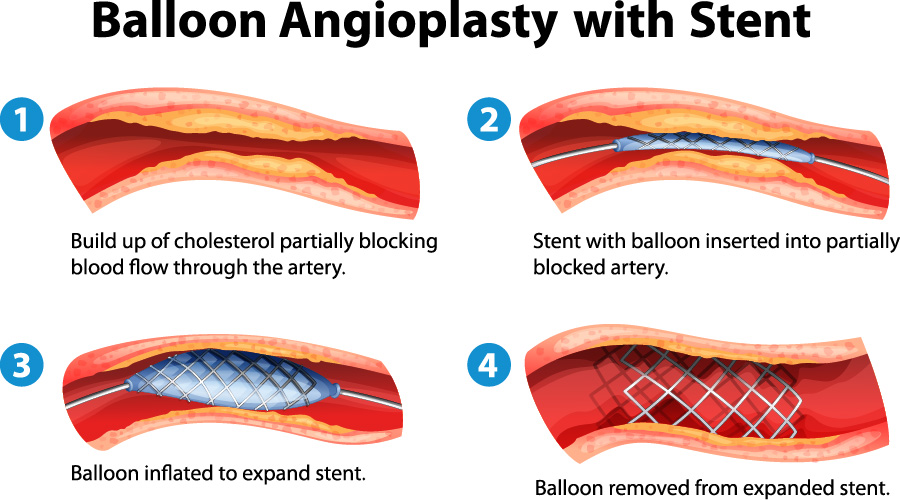Also known as: Percutaneous Transluminal Coronary Angioplasty (PTCA), coronary angioplasty, balloon angioplasty
Duration: 30 to 60 minutes (but can take longer depending on complexities)
Percutaneous Coronary Intervention (PCI) is the combination of balloon angioplasty with stent placement.
Balloon angioplasty is performed after a cardiac catheterization to open up a blocked or narrowed coronary artery (the major blood vessel supplying the heart). It is a minimally invasive procedure that restores the blood flow to the heart without the need for open-heart surgery. This procedure is usually followed by placing a stent (a short, wire-mesh tube) into the affected artery.

Access Sites:
- Transfemoral – performed through your femoral artery (groin area)
- Radial – performed through your radial artery (wrist area)
Uses:
- For persistent chest pain not responding to medical therapy
- To open blocked coronary arteries (when bypass surgery is not appropriate)
- As an emergency treatment in acute heart attacks
Preparing for the procedure:
![]() Download Pre Procedure Instructions
Download Pre Procedure Instructions
How the procedure is performed:
Balloon Angioplasty
- Firstly, a diagnostic cardiac catheterization is performed to check for any blocks in the coronary arteries. A catheter (a thin, long tube) is placed in either your arms, legs, or groin and is monitored by an x-ray camera until it reaches the coronaries.
- A contrast dye is then infused so that the arteries can be seen.
- In a balloon angioplasty, the tip of the catheter will be fitted into the blocked artery and the balloon is inflated. This pushes the plaque against the wall of the artery, creating more space for blood to flow easily.
- Once blood flow is established, the catheter is deflated and removed.
Stent Placement
- Most patients who undergo balloon angioplasty may also have a stent (a small, collapsed tube made of wire mesh) placed inside the treated artery.
- The balloon of the stent is inflated, causing it to expand against the wall of the artery.
- Once placed, the balloon is deflated and withdrawn.
Stent Types:
- Drug-Eluting Stents (DES) – is coated with medication to keep the arteries from clogging again and to prevent scar formation. Most stents are of this type.
- Bare Metal Stents (BMS) – is not coated with medication
After the procedure:
![]() Download Post Procedure Instructions
Download Post Procedure Instructions
Show references
Malik TF, Tivakaran VS. Percutaneous Transluminal Coronary Angioplasty (PTCA) [Updated 2020 Jun 28]. In: StatPearls [Internet]. Treasure Island (FL): StatPearls Publishing; 2020 Jan-. Available from: https://www.ncbi.nlm.nih.gov/books/NBK535417/
Granada JF, Price MJ, French PA, et al. Platelet-mediated thrombosis and drug-eluting stents. Circ Cardiovasc Interv. 2011;4(6):629-637. doi:10.1161/CIRCINTERVENTIONS.111.964635
Schmidt T, Abbott JD. Coronary Stents: History, Design, and Construction. J Clin Med. 2018;7(6):126. Published 2018 May 29. doi:10.3390/jcm7060126.
Faxon DP, et al., eds. Percutaneous coronary interventions and other interventional procedures. In: Harrison’s Principles of Internal Medicine. 20th ed. The McGraw-Hill Education; 2019. http://accessmedicine.mhmedical.com. Retrieved Aug. 2020.
